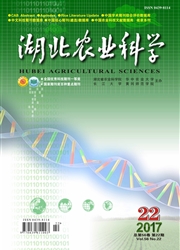

 中文摘要:
中文摘要:
为了明确氮肥运筹对早稻两优287机械栽植产量形成的作用机制,在总施氮量(纯氮)为150 kg/hm2条件下,设置基肥、分蘖肥、穗肥比例分别为7:3:0(N1)、6:3:1(N2)、5:3:2(N3)、4:3:3(N4)和3:3:4(N5)5个氮肥运筹模式,分析水稻根系形态与伤流量、叶绿素、茎鞘干物质转运和产量构成因素等状况。结果表明,①各处理间产量及氮肥农学利用率均以N3最高,与其他处理间差异达显著水平;以N5最低,与其他处理间差异也均达显著水平。②随着氮肥的后移,水稻总根长和根比表面积呈降低趋势,根数和根干重以N3最大,其根系伤流量也最大。③N5水稻叶片SPAD值灌浆期和收获期相对较高,出现贪青现象。④N3和N4的茎鞘物质输出率和茎鞘物质转换率较低,叶片干物质输出率为负值。从而得知,早稻两优287机械栽植,在基肥、分蘖肥、穗肥中氮比例为5:3:2时有利于提高生育后期的根系活力、形成有效利用养分的根系特征、促进叶片光合能力的发挥,最终取得较高产量。
 英文摘要:
英文摘要:
To test the role of nitrogen management patterns in the yield formation of early rice variety Liangyou 287,under the same total N application of 150 kg / hm2,five application patterns with the application ratio of base fertilizer,tillering fertilizer and panicle fertilizer at 7∶3∶0(N1),6∶3∶1(N2),5∶3∶2(N3),4∶3∶3(N4) and 3∶3∶4(N5),respectively were set,and the roots morphology and bleeding amount,chlorophyll content,dry matter transporting and yield formation were investigated.The results showed that,①the yield and N fertilizer agronomic use efficiency was both the highest in N3 treatment,and was significantly higher than other treatments;while of N5 was the lowest,and was significantly lower than other treatments.②As N fertilizer delayed,the total root length and root specific area were decreasing,the root number,root dry weight as well as root bleeding amount was the highest in N3 treatment.③Rice leaf in N5 treatment remained green when it was due to become yellow and ripe as the SPAD value was relatively high in pustulation period and harvest time.④The EPMSS(exporting percentage of matter of stem and sheath) and TPMSS(transporting percentage of matter of stem and sheath) of N3 and N4 were low;EPML(exporting percentage of matter of leaves) was negative.It was concluded that with machinery planting,the ratio of N in basal fertilizer,tillering fertilizer,panicle fertilizer at 5∶3∶2 could help improve the activity of root system at late growth stage,form root system that could uptake nutrient effectively,promote the photosynthetic ability of leaves,thus lead to high rice yield.
 同期刊论文项目
同期刊论文项目
 同项目期刊论文
同项目期刊论文
 Effect of Enhanced Panicle Fertilization on Nitrogen Use Efficiency Traits of Rice (Oryza Sativa) wi
Effect of Enhanced Panicle Fertilization on Nitrogen Use Efficiency Traits of Rice (Oryza Sativa) wi Influence of the Improved System of Rice Intensification (SRI) on Rice Yield, Yield Components and T
Influence of the Improved System of Rice Intensification (SRI) on Rice Yield, Yield Components and T 期刊信息
期刊信息
